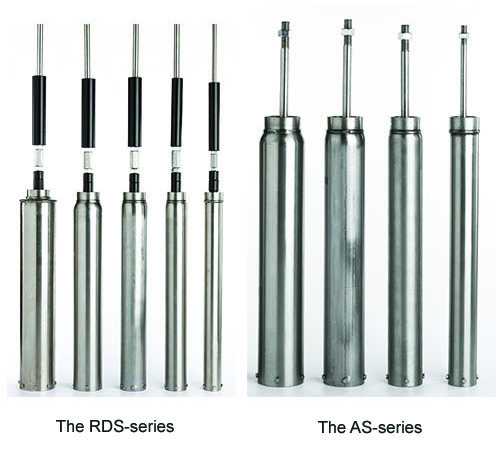Jooste Cylinders through the decades
The Jooste Cylinder and Pump Company was established in 1967 and has since then concentrated on improving the ordinary borehole cylinder. The cylinder on the market at the time was made of brass with leather cup washers, this caused frictional resistance between the leather cup washers and the casing (the leather washers wore out easily and required replacement often which resulted in the continual removal of all the piping). Excess force was needed to pump water, especially in deep boreholes.
The J-model
The first Jooste cylinder (J-model), for deep boreholes, operated telescopically (a cylindrical tube sliding through a neoprene packing) and was manufactured from galvanized steel, with the internal housing and sealing surface made of brass, however the electrolytic corrosion caused the outer galvanized casing to rust quite quickly.
To improve the cylinder, Mr Jooste replaced the brass internal housing with stainless steel although the sealing surface was still made from brass, the electrolytic corrosion was less but still evident. He then decided that he had to redesign the J-Model. The top, bottom and inner tubes were all now made out of stainless steel. The new cylinder became known as the JS-Model and was manufactured in 4 different sizes. It was the first time that stainless steel cylinders were used in boreholes.
As these cylinders were used only for deep boreholes and the market was limited, it was time to develop a cylinder for the use in shallow boreholes that was more efficient that the brass cylinder with the leather cup washers.
FROM LEFT TO RIGHT 1) Testing the first cylinders 2) The J-model 3) The improved model 4) The first AS cylinders
Minimising electrolytic corrosion
The AS-Cylinder was then designed with the tube made out of stainless steel, thus minimising electrolytic corrosion. Polyurethane rings were used instead of the leather washers. These changes increased the efficiency of the cylinder considerably; the new cylinder required extremely light operating power and increased the delivery by 40% of the conventional cylinder.
In time, the AS-RDS range replaced the JS-Model for the use in deep boreholes. In the AS-RDS range the piston consists of two polyurethane rings instead of one as in the AS range. This cylinder also has a rod support and a rust retainer.
In 1993 the Jooste Cylinder received the Cullinan Design Award as an example of good engineering design.
The AS-range and RDS-range cylinders as manufactured today. The spare parts are now easily distinguishable according to size depending on the colour. Other revolutionary Jooste products include the Jooste Force Cylinder for surface pumping and the Jooste Forcehead. It is used to seal off water at great pressures allowing the water to be pumped up to 180m above the surface level with ease.

Minimising electrolytic corrosion
The AS-Cylinder was then designed with the tube made out of stainless steel, thus minimising electrolytic corrosion. Polyurethane rings were used instead of the leather washers. These changes increased the efficiency of the cylinder considerably; the new cylinder required extremely light operating power and increased the delivery by 40% of the conventional cylinder.
In time, the AS-RDS range replaced the JS-Model for the use in deep boreholes. In the AS-RDS range the piston consists of two polyurethane rings instead of one as in the AS range. This cylinder also has a rod support and a rust retainer.
In 1993 the Jooste Cylinder received the Cullinan Design Award as an example of good engineering design.
The AS-range and RDS-range cylinders as manufactured today. The spare parts are now easily distinguishable according to size depending on the colour. Other revolutionary Jooste products include the Jooste Force Cylinder for surface pumping and the Jooste Forcehead. It is used to seal off water at great pressures allowing the water to be pumped up to 180m above the surface level with ease.
FROM LEFT TO RIGHT 1) The AS-series 2) The RDS cylinder